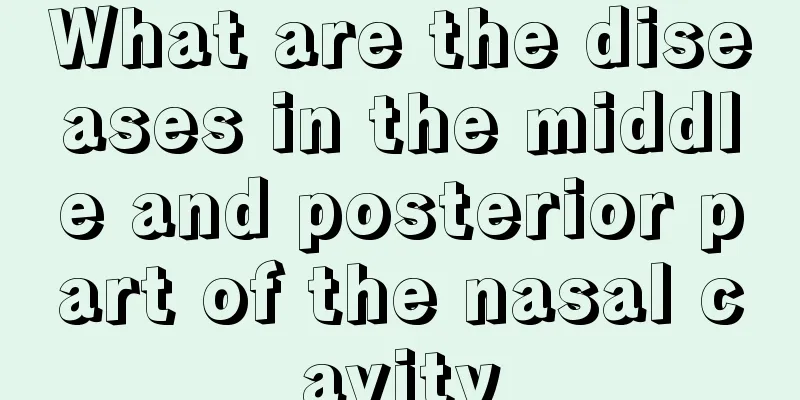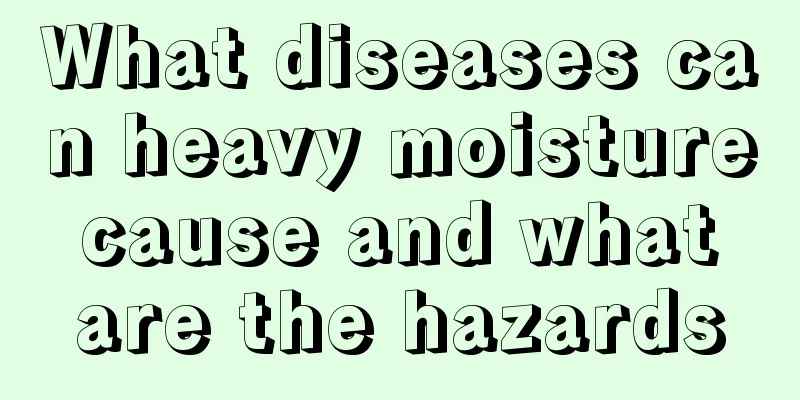What are the diseases in the middle and posterior part of the nasal cavity

|
I believe everyone must be curious about the diseases in the middle and back of the nasal cavity. The nose is an organ that we cannot live without at all times. If it is sick, you can imagine how much pain we will suffer. As the masters of our bodies, we have the obligation to protect the health of each organ. So let’s take a look at the diseases in the middle and back of the nasal cavity. 1. Rhinitis Rhinitis refers to inflammation of the nasal mucosa and submucosal tissues. It manifests as congestion or edema, and patients often experience symptoms such as nasal congestion, clear runny nose, nasal itching, throat discomfort, and cough. The thin liquid-like substance secreted by the nasal cavity is called snot or nasal secretion. Its function is to help remove dust and bacteria to keep the lungs healthy. Normally, nasal mucus mixed with bacteria and dust is inhaled into the throat and eventually enters the stomach. Because the amount of secretion is very small, it generally does not attract people's attention. When inflammation occurs in the nose, a large amount of nasal mucus can be secreted in the nasal cavity, and it may turn yellow due to the infection. It can cause coughing when flowing through the throat. When the amount of nasal mucus is very large, it can also flow out through the anterior nostril. 2. Sinusitis Inflammation of one or more sinuses is called sinusitis. The affected sinuses include the maxillary sinus, ethmoid sinus, frontal sinus and sphenoid sinus. This is a disease with a high incidence rate in the population and affects the quality of life of patients. Sinusitis can be divided into 2 types: acute and chronic sinusitis. Acute sinusitis is mostly caused by upper respiratory tract infection, and bacterial and viral infections may occur simultaneously. Chronic sinusitis is more common than acute sinusitis, and multiple sinuses are often affected at the same time. 3. Nasal polyps Nasal polyps are a common nasal disease, which is formed when the extremely edematous nasal sinus mucosa gradually sags under the action of gravity. 4. Deviated nasal septum When the nasal septum bends to one or both sides, or one or both sides of the nasal septum protrude locally, causing physiological dysfunction of the nasal cavity and sinuses and producing symptoms (such as nasal congestion, nosebleed, headache, etc.), it is called nasal septum deviation. 5. Hypertrophy of nasal conchae Turbinate hypertrophy refers to the long-term inflammatory stimulation of the nasal concha, which causes edema of the nasal concha mucosa and leads to nasal obstruction. For some hypertrophic inferior turbinates, the use of nasal mucosal vasoconstrictors and Chinese and Western medicines for treatment has poor results. In addition to drug treatment, other methods to improve nasal ventilation include partial resection of the inferior turbinate, cryosurgery, microwave, laser and partial resection with a nasal polyp cutter; however, the above methods cause greater damage to the inferior turbinate mucosa, resulting in postoperative pain, bleeding, scabs, dryness, nasal odor, infection, and nasal adhesions, which affect the function of the nasal cavity to varying degrees. According to current medical knowledge, it is best not to undergo surgery on the nasal concha, as it is the thermostat of the nasal cavity. If it is damaged too much, the sense of cold and warm air will be lost. 6. Nosebleed The symptoms of nosebleed vary depending on the cause. Most nosebleeds are unilateral, but they can also be bilateral. They can be intermittent and recurrent, or they can be continuous. The amount of bleeding varies. In mild cases, there may be blood in the mucus, a few drops or a few milliliters. In severe cases, it may reach dozens of milliliters or even hundreds of milliliters, leading to hemorrhagic shock. Repeated bleeding can cause anemia. A small amount of bleeding may stop on its own or after compression. From the above we can know what diseases there are in the middle and posterior nasal cavity. Seeing the pain and harm these diseases bring us, we must pay attention to maintaining a healthy diet, drink plenty of water, maintain normal work and rest and eating habits. If you have an allergic constitution, you must be extra careful to protect yourself, so that you can stay healthy and away from diseases. |
<<: What is the most effective way to prevent headaches
>>: Postoperative care precautions
Recommend
What are the benefits of anthocyanin plants to the human body
If you want your body to stay healthy, you must r...
What are the nursing methods for colorectal cancer
The occurrence of colorectal cancer has a lot to ...
Can people with skin cancer eat protein powder
Can skin cancer patients take protein powder? Abo...
What are the contraindications of Jiangdou's effects?
Jiang beans are a common type of bean in our dail...
Laryngeal cancer patients will experience dyspnea in the late stage
There are many symptoms of advanced laryngeal can...
What should you pay attention to if you want to prevent cervical cancer? What are the methods to prevent cervical cancer?
Cervical cancer is a common female disease, mainl...
How to broaden your shoulders
For men, their shoulders are the support of women...
What to eat to help liver fibrosis
What is the best food for liver fibrosis? Many pa...
Why does the right side of my waist hurt?
Low back pain is a very common phenomenon for man...
The efficacy and function of cypress seeds as pillows
Cypress is a relatively common tree species in my...
What are the symptoms of central lung cancer? Four common symptoms of central lung cancer
There are many types of lung cancer, and central ...
The hazards of ice pillow
In summer, the weather is too hot and everyone wi...
How to clean cuttlefish
Cuttlefish has high nutritional value and delicio...
How long is the appropriate time to steam in a sauna
The history of sauna is very long, and it mainly ...
What is the reason for numbness in the left instep
When some phenomena appear in our body, we must p...









